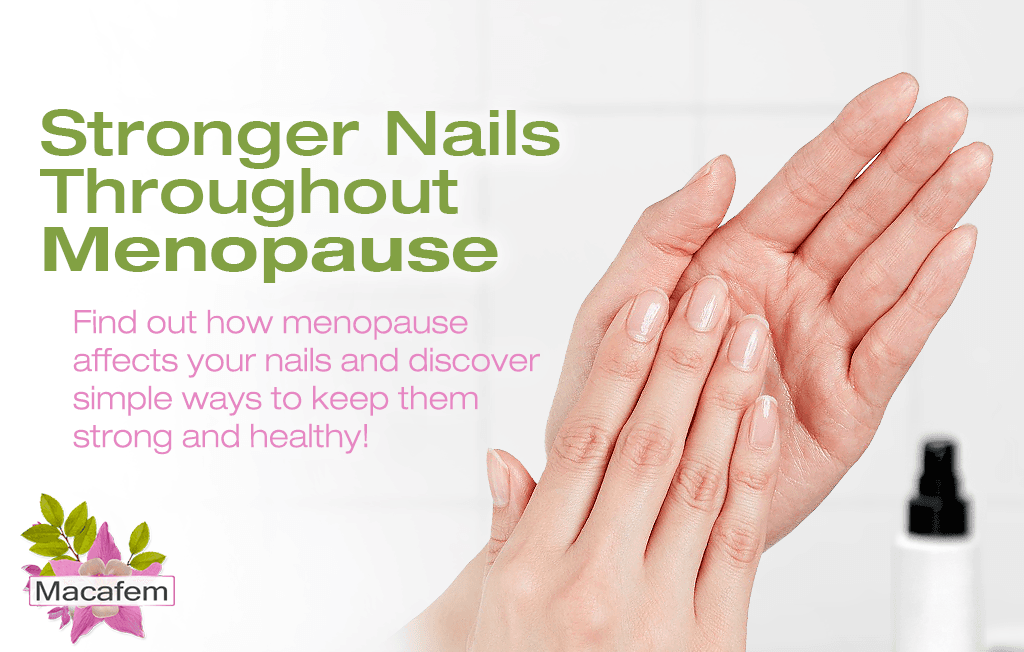Stronger Nails Throughout Menopause
Menopause is a time of transformation, affecting everything from energy levels to skin texture, and even nails. Many women notice their once-strong nails becoming brittle, peeling, or breaking more easily. While this change can be frustrating, it’s not uncommon. The good news is that brittle nails aren’t a permanent problem. By understanding why this happens and making small, mindful adjustments, you can restore strength and flexibility to your nails, keeping them healthy through this new stage of life.

Why Do Nails Become Brittle During Menopause?
Hormonal shifts play a major role in the condition of your nails. Estrogen, a hormone that declines significantly during menopause, helps the body retain moisture and supports collagen production. When estrogen levels drop, nails become drier, weaker, and more prone to splitting.
But hormones aren’t the only factor at play. Other contributors include:
- Nutrient deficiencies. As the body adjusts to hormonal changes, it may absorb nutrients less efficiently. Low levels of biotin, iron, zinc, and omega-3 fatty acids can affect nail strength.
- Thyroid function. Some women experience thyroid imbalances during menopause, which can lead to slow-growing, brittle nails.
- Dehydration. Since estrogen helps with water retention, its decline may cause nails to become drier and more fragile.
- Environmental stressors. Frequent handwashing, exposure to cleaning products, and excessive use of nail polish removers can strip nails of essential moisture and make them more brittle.
Because brittle nails can indicate an underlying health condition, it’s a good idea to consult a physician, especially if you notice other concerning symptoms.
Supporting Hormonal Balance
Since hormonal fluctuations are a key cause of brittle nails during menopause, supporting hormonal balance can help restore their strength.
Being 100% natural and packed with hormone-balancing compounds, Macafem is a gentle ally for the endocrine system. By helping the body regulate its own hormone production naturally, it can help ease symptoms of hormonal imbalance, including brittle nails, among many others.
Additionally, phytoestrogen-rich supplements, like black cohosh, as well as adaptogenic herbs, such as ashwagandha, can also help promote hormonal balance in the short term.
Regular exercise and stress management also play a role in keeping hormones stable, promoting stronger nails from within.
Nourishing Nails from the Inside Out
Healthy nails start from within, and the right diet can make a noticeable difference.
Protein is a key building block since nails are made of keratin, a tough structural protein. Including enough lean protein sources, such as eggs, fish, nuts, and legumes, can promote nail resilience.
Biotin, often called the “beauty vitamin,” is another important nutrient. Studies have shown that supplementing with biotin can improve nail thickness and reduce brittleness. Foods rich in biotin include almonds, sweet potatoes, and whole grains.
Iron and zinc are also essential, as deficiencies can lead to weak, slow-growing nails. Dark leafy greens, lentils, pumpkin seeds, and fortified cereals are great sources of these minerals.
Lastly, hydration plays a major role. Drinking plenty of water keeps nails flexible and less prone to cracking. Herbal teas, especially those rich in silica, like horsetail tea, can provide an extra boost.
Best Habits for Stronger Nails
Daily nail care can prevent breakage and keep your nails in their best condition.
- Moisturizing regularly is one of the easiest and most effective habits. Using a cuticle oil or a hand cream with nourishing ingredients like shea butter, vitamin E, or jojoba oil can help seal in moisture.
- When it comes to nail grooming, a gentle approach is best. Filing in one direction (rather than sawing back and forth) prevents splitting. Keeping nails at a moderate length reduces the chances of breakage.
- It’s also important to protect nails from harsh chemicals. Wearing gloves while doing dishes or cleaning prevents nails from becoming overly dry or damaged by detergents and solvents.
Some women turn to nail hardeners to combat brittleness, but not all products are created equal. Those containing formaldehyde can actually make nails more brittle over time. Opting for formulas with strengthening ingredients like keratin or calcium can provide support without causing further damage.
Menopause brings many changes, but brittle nails don’t have to be one of them. By nourishing your body with the right nutrients, supporting hormonal balance with Macafem, and keeping up with gentle nail care, you can maintain strong, healthy nails throughout this transition. Small adjustments can lead to big improvements, helping your nails stay as resilient as you are.
Dermatology and Therapy. (2019). Pathogenesis, Clinical Signs and Treatment Recommendations in Brittle Nails: A Review. Retrieved February 11, 2025, from https://pmc.ncbi.nlm.nih.gov/articles/PMC6994568/
Indian Journal of Dermatology. (2019). A Cross-Sectional Study on the Dermatoses in Postmenopausal Patients at a Rural-Based Tertiary Health Care Center. Retrieved February 11, 2025, from https://pmc.ncbi.nlm.nih.gov/articles/PMC6749754/
Journal of Drugs in Dermatology. (2017). Vitamins and minerals: their role in nail health and disease. Retrieved February 11, 2025, from https://pubmed.ncbi.nlm.nih.gov/17763607/
National Institutes of Health. (222). Biotin. Retrieved February 11, 2025, from https://ods.od.nih.gov/factsheets/Biotin-HealthProfessional/
Skin Appendage Disorders. (2017). A Review of the Use of Biotin for Hair Loss. Retrieved February 11, 2025, from https://pmc.ncbi.nlm.nih.gov/articles/PMC5582478/

